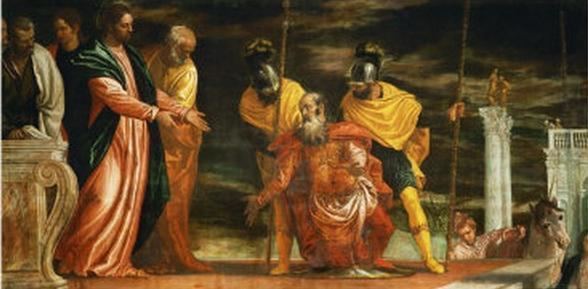 | ||
Healing the centurion's servant is one of the miracles said to have been performed by Jesus of Nazareth as related in the Gospels of Matthew and Luke. The story is not recounted by either John or Mark.
Contents
According to these accounts, a Roman centurion asked Jesus for his help because his boy servant was ill. Jesus offered to go to the centurion's house to perform a healing, but the centurion demurred and suggested that Jesus' word of authority from where he was at that moment would be sufficient. Impressed, Jesus commented approvingly of the strong religious faith displayed by the soldier and granted the request, which resulted in the servant being healed the same day.
Scriptures
Matthew 8:5–13 (TNVI)
Luke 7:1–10 (TNVI)
Commentary
Luke 7:2 and 7:10 refer to the person to be healed as doulos, unambiguously meaning "servant" but has the centurion himself call him "pais" <Stephens 1550> - which has a number of more ambiguous meanings including "child" (e.g., Matt 2:16; Luke 2:43,8:51-54 where it refers to a girl), "son" (John 4:51), "servant" (Luke 15:26, Acts 4:25), "male concubine", or be unclear.
Homo-erotic connotations
According to James Neill, the Greek term "pais" used for the servant in Matthew's account almost always had a sexual connotation. In support of this view, he remarks that the word pais, along with the word "erasthai" (to love) is the root of the English word "pederasty". He sees in the fact that, in Luke's parallel account, the centurion's servant is described as "valued highly" by the centurion an indication of a homosexual relationship between the two, and says that the Greek word "doulos" used of him in Luke's account suggests he may even have been a sex slave. Daniel A. Helminiak agrees that the word pais could have a sexual meaning. Theodore W. Jennings Jr. and Tat-Siong Benny Liew further write that Roman historical data about patron-client relationships and about same-sex relations among soldiers support the view that the pais in Matthew's account is the centurion's "boy-lover", and that the centurion therefore did not want Jesus to enter his house for fear perhaps that the boy would be enamoured of Jesus instead. D.B. Saddington writes that while he does not exclude the possibility, the evidence the two put forward supports "neither of these interpretations".
